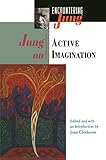Jung on Active Imagination / C. G. Jung; ed. by Joan Chodorow.
Material type: TextSeries: Encountering JungPublisher: Princeton, NJ : Princeton University Press, [2015]Copyright date: ©1997Description: 1 online resource (208 p.)Content type:
TextSeries: Encountering JungPublisher: Princeton, NJ : Princeton University Press, [2015]Copyright date: ©1997Description: 1 online resource (208 p.)Content type: - 9780691015767
- 9781400866854
- Active imagination
- Jungian psychology
- Psychoanalysis
- Subconsciousness
- PSYCHOLOGY / Movements / Psychoanalysis
- Active imagination
- Adlerian
- Allusion
- Analogy
- Analytical psychology
- Anima and animus
- Anthropomorphism
- Antithesis
- Apotropaic magic
- Archetype
- Art therapy
- Astrology
- Author
- Career
- Carl Jung
- Causality
- Certainty
- Cherry picking
- Circumference
- Clockwise
- Cloister
- Co-operation (evolution)
- Consciousness
- Critical period
- Criticism
- Dialectic
- Direct experience
- Disgust
- Dissociation (psychology)
- Dream interpretation
- Explanation
- Extraversion and introversion
- Feeling
- Free association (psychology)
- Hallucination
- Humility
- Ibid
- Imagination
- Indication (medicine)
- Individuation
- Inner Experience
- Inner critic
- Introspection
- Invention
- Lao-Tzu
- Lecture
- Libido
- Literature
- Loneliness
- Mental image
- Mood (psychology)
- Multitude
- Mysterium Coniunctionis
- Neglect
- Neurosis
- Nihilism
- Oppression
- Parapsychology
- Personality
- Phenomenon
- Philosophy
- Potentiality and actuality
- Prejudice
- Prima materia
- Principle
- Probability
- Psyche (psychology)
- Psychoanalysis
- Psychologist
- Psychology and Alchemy
- Psychology
- Psychotherapy
- Puberty
- Rapprochement
- Rationality
- Reality
- Reincarnation
- Result
- Sanskrit
- Self-confidence
- Self-deception
- Self-knowledge (psychology)
- Sigmund Freud
- Singing
- Suffering
- Suggestion
- Suicide
- Symptom
- Temperament
- The Erotic
- The Interpretation of Dreams
- The Secret of the Golden Flower
- Therapeutic effect
- Thought
- Toni Wolff
- Transference
- Two Essays on Analytical Psychology
- Uncertainty
- Wreath
- Writing
- 153.3 22
- online - DeGruyter
| Item type | Current library | Call number | URL | Status | Notes | Barcode | |
|---|---|---|---|---|---|---|---|
 eBook
eBook
|
Biblioteca "Angelicum" Pont. Univ. S.Tommaso d'Aquino Nuvola online | online - DeGruyter (Browse shelf(Opens below)) | Online access | Not for loan (Accesso limitato) | Accesso per gli utenti autorizzati / Access for authorized users | (dgr)9781400866854 |
Browsing Biblioteca "Angelicum" Pont. Univ. S.Tommaso d'Aquino shelves, Shelving location: Nuvola online Close shelf browser (Hides shelf browser)

|

|

|

|

|

|

|
||
| online - DeGruyter Garden Insects of North America : The Ultimate Guide to Backyard Bugs / | online - DeGruyter For the Glory of God : How Monotheism Led to Reformations, Science, Witch-Hunts, and the End of Slavery / | online - DeGruyter The Mustard Seed Garden Manual of Painting : A Facsimile of the 1887-1888 Shanghai Edition / | online - DeGruyter Jung on Active Imagination / | online - DeGruyter Cities of Knowledge : Cold War Science and the Search for the Next Silicon Valley / | online - DeGruyter Erased : Vanishing Traces of Jewish Galicia in Present-Day Ukraine / | online - DeGruyter Personal Roots of Representation / |
Frontmatter -- Contents -- List of illustrations -- List of abbreviations used in notes -- Acknowledgements -- Introduction -- 1. Confrontation with the unconscious -- 2. The transcendent function -- 3. 'The technique of differentiation between the ego and the figures of the unconscious' -- 4. Commentary on The Secret of the Golden Flower -- 5. The aims of psychotherapy -- 6. A study in the process of individuation -- 7. The Tavistock lectures -- 8. The psychological aspects of the Kore -- 9. On the nature of the psyche -- 10. Three letters to Mr O. (1947) -- 11. Mysterium Coniunctionis -- 12. Foreword to van Helsdingen: Beelden uit het Onbewuste -- Afterword: Post-Jungian contributions -- Bibliography -- List of fantasies and visions -- Subject index -- Name index
restricted access online access with authorization star
http://purl.org/coar/access_right/c_16ec
All the creative art psychotherapies (art, dance, music, drama, poetry) can trace their roots to C. G. Jung's early work on active imagination. Joan Chodorow here offers a collection of Jung's writings on active imagination, gathered together for the first time. Jung developed this concept between the years 1913 and 1916, following his break with Freud. During this time, he was disoriented and experienced intense inner turmoil --he suffered from lethargy and fears, and his moods threatened to overwhelm him. Jung searched for a method to heal himself from within, and finally decided to engage with the impulses and images of his unconscious. It was through the rediscovery of the symbolic play of his childhood that Jung was able to reconnect with his creative spirit. In a 1925 seminar and again in his memoirs, he tells the remarkable story of his experiments during this time that led to his self-healing. Jung learned to develop an ongoing relationship with his lively creative spirit through the power of imagination and fantasies. He termed this therapeutic method "active imagination." This method is based on the natural healing function of the imagination, and its many expressions. Chodorow clearly presents the texts, and sets them in the proper context. She also interweaves her discussion of Jung's writings and ideas with contributions from Jungian authors and artists.
Mode of access: Internet via World Wide Web.
In English.
Description based on online resource; title from PDF title page (publisher's Web site, viewed 03. Jan 2023)


